topic 2 I) excretion
1/18
There's no tags or description
Looks like no tags are added yet.
Name | Mastery | Learn | Test | Matching | Spaced |
|---|
No study sessions yet.
19 Terms
why do plants need excretion
there are many metabolic reactions taking place that produce waste products
these waste products can either be used up in other processes or some exit the plant via the leaf organ
waste products in excess:
oxygen
CO2
water/water vapour
other unwanted chemical substances
waste products during the day v night
day net effect: oxygen in excess and waste product as photosynthesis>respiration
night net effect: carbon dioxide in excess and waste product as respiration>photosynthesis
excess gas diffuses out of stomata
how is water vapour lost in plants
majority of water vapour lost is not a waste product of metabolism, but instead water that has been drawn up from roots in transpiration stream
how are chemical substances excreted in plants
most molecules that are no longer needed by the plant can be broken down into chemical substances
some substances cannot be converted into another useful compound so must be removed
chemical waste materials can be stored in the dying tissues of a plant
when the dying tissue falls off the plant the substances are removed
why do humans need excretion
waste products produced from many metabolic reactions in cells
excretion is the removal of waste substances of metabolic reactions, toxic materials and substances in excess of requirements
metabolic wastes include:
CO2 and water from aerobic respiration
urea produced by breakdown of excess proteins (amino acids) in liver
other excesses substances e.g. medical drugs and dietary minerals
what happens when waste products are not excreted
if they are allowed to build up:
toxicity - they have toxic effects if they are allowed to reach high concentrations e.g. CO2 dissolves into water easily to form acidic solution that can lower the pH of cells, reducing enzyme activity in body
osmotic effect - body fluids can become more concentrated due to higher amounts of waste products - concentrated body fluids can cause water to move out of cells, changing water potential and preventing them from carrying out essential reactions
using up necessary storage - space within organism is limited and is required for the storage of more useful molecules
excretory organs of the human body
kidney for urea, water, excess salts (in urine, urea comes from liver)
lungs for CO2 and water (during exhalation)
skin for excess mineral ions and water as well as some urea (via sweating)
what is the kidney
2 located in back of abdomen
regulate water content of blood (vital for maintaining blood pressure and osmoregulation)
excrete toxic waste products of metabolism (e.g urea) and substances that are in excess e.g. salts
what is osmoregulation and why is it important
process of maintaining water and salt concentrations across membranes within the body
it is an example of homeostasis
importance:
cytoplasm is largely composed of water, so is the blood plasma
maintaining water levels is vital to prevent harmful changes occurring to cells of the body as a result of osmosis
if body cells lose or gain too much water by osmosis they do not function efficiently:
too much water in blood causes cells swelling as water moves in - has diluting effect and can lead to cells bursting
too little water in blood means cells lose water by osmosis - has dehydrating effect and can lead to cell death
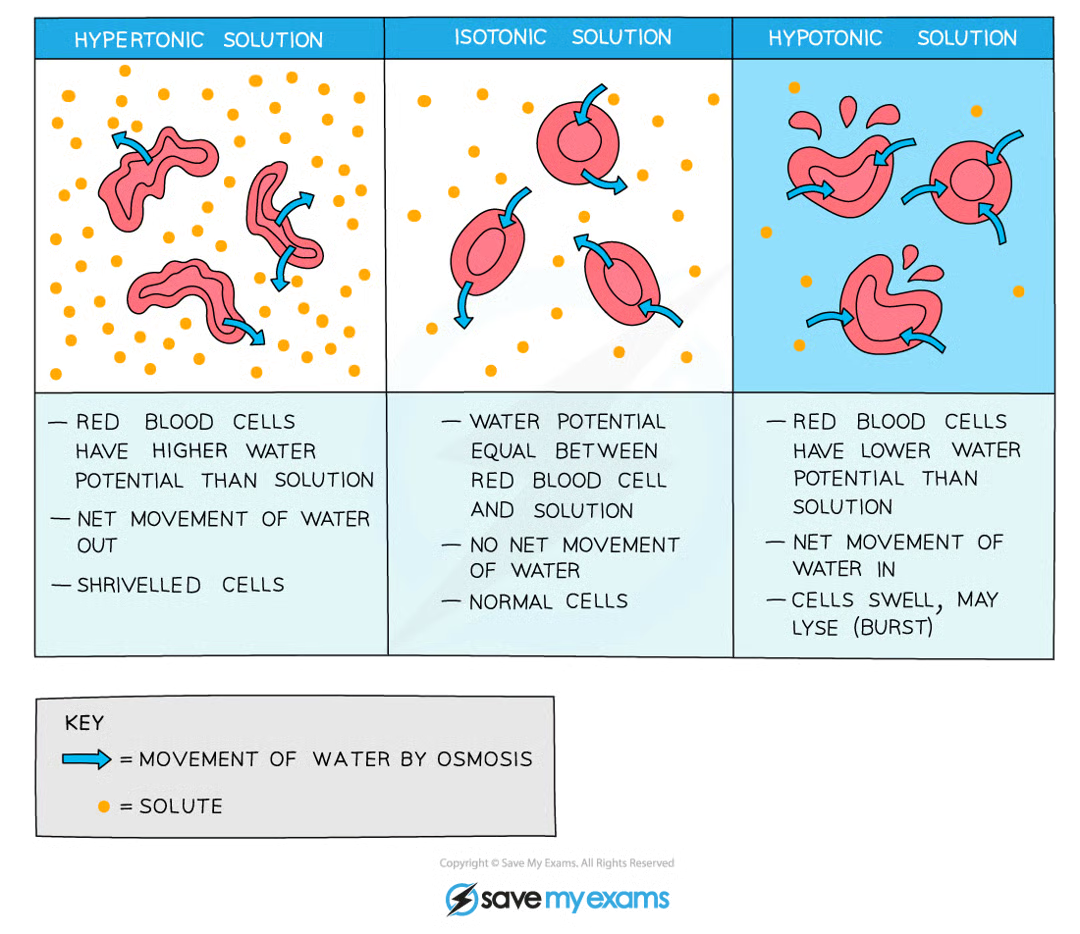
water content of the body
two sources of water:
product of aerobic respiration
water in diet
water loss through:
lungs during exhalation
skin as sweat
water loss through these cannot be controlled, but volume of water lost in urine can be controlled by kidneys
structure of urinary system
functions:
to filter waste products from blood and expel it as urine
to control water levels of body (osmoregulation)
structure:
2 kidneys joined to bladder by two tubes called ureters
another tube carries urine from bladder (stores urine) to outside body called urethra
each kidney is also connected to
renal artery - comes from aorta and delivers oxygenated blood to kidney
renal vein - delivers deoxygenated blood from kidney to vena cava
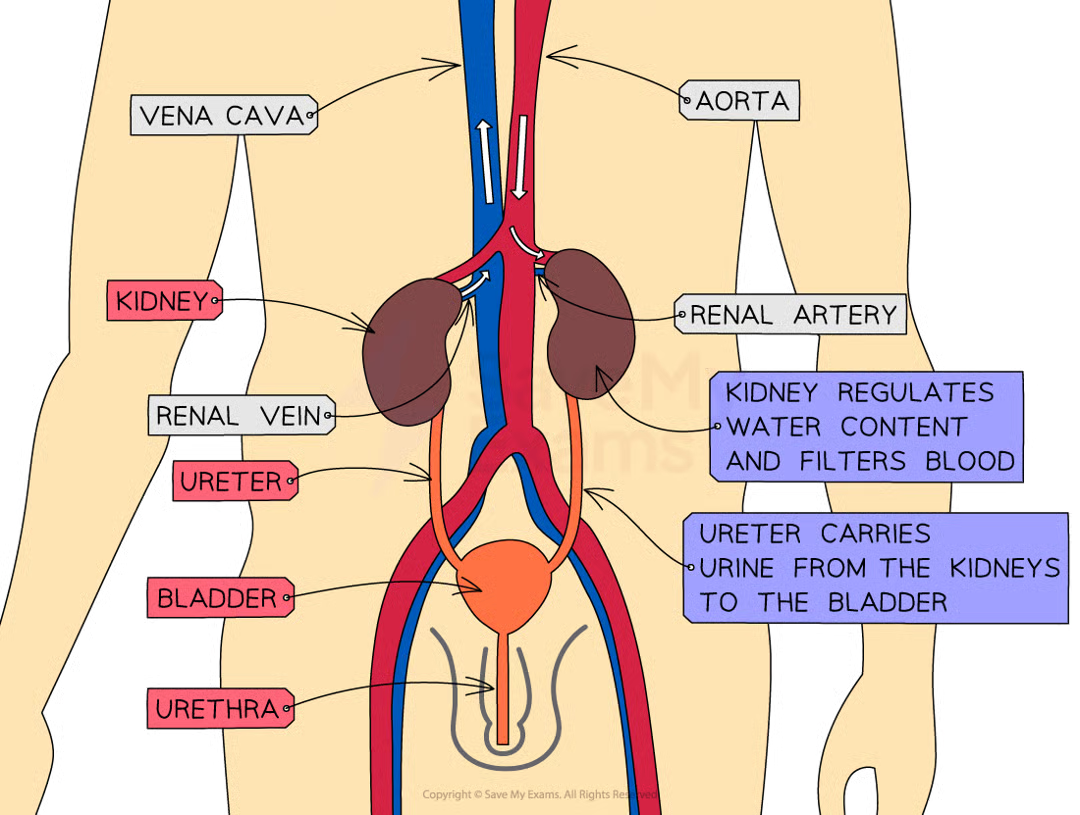
structure of kidneys
three regions:
cortex - outermost region
medulla - inner section
renal pelvis - tube linking kidney to ureter
each kidney has around a million tiny structures called nephrons/kidney tubules/renal tubules
nephrons start at the cortex and loop down into the medulla and back to the cortex
contents of nephrons drain the renal pelvis and urine collects there before it flows into the ureter to be carried to the bladder for storage
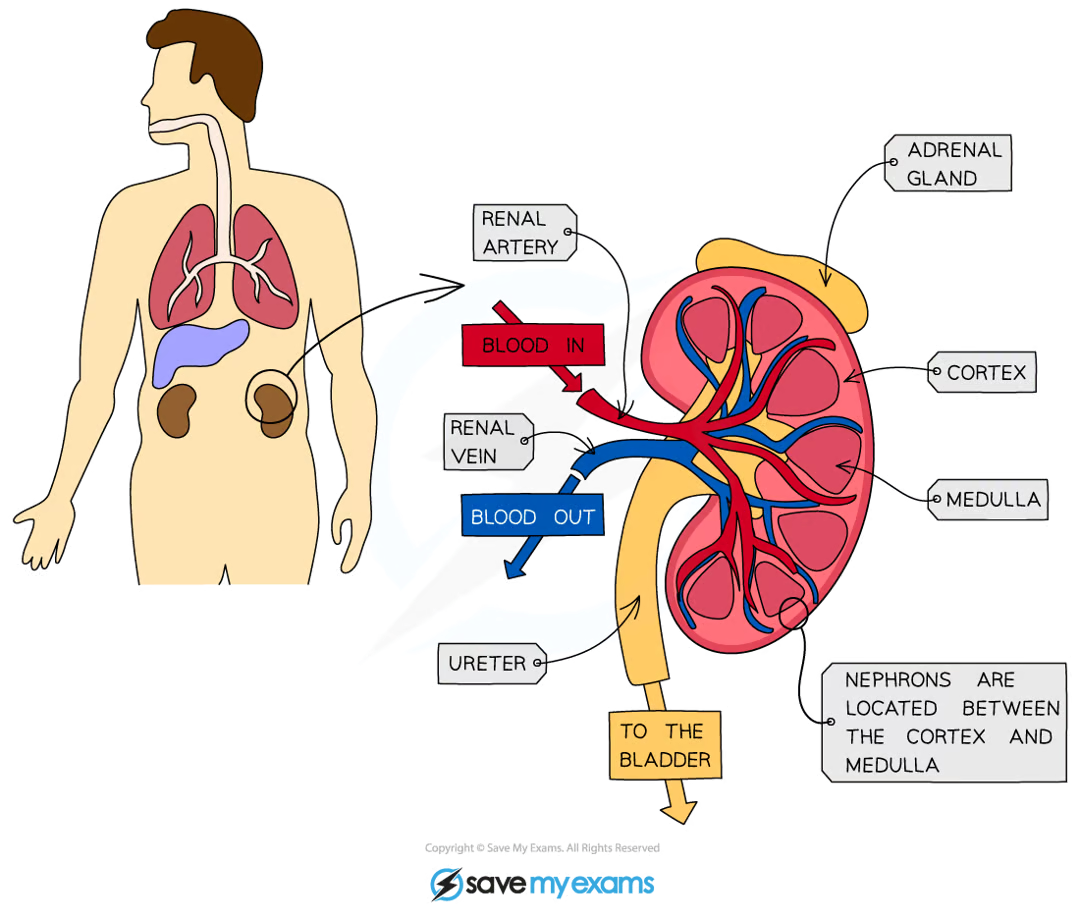
structure of a nephron
bowman’s capsule, surrounds glomerulus
proximal convoluted tubule
loop of henle
distal convoluted tubule
collecting duct
network of capillaries surrounding tubule with knotted section that sits inside bowman’s capsule
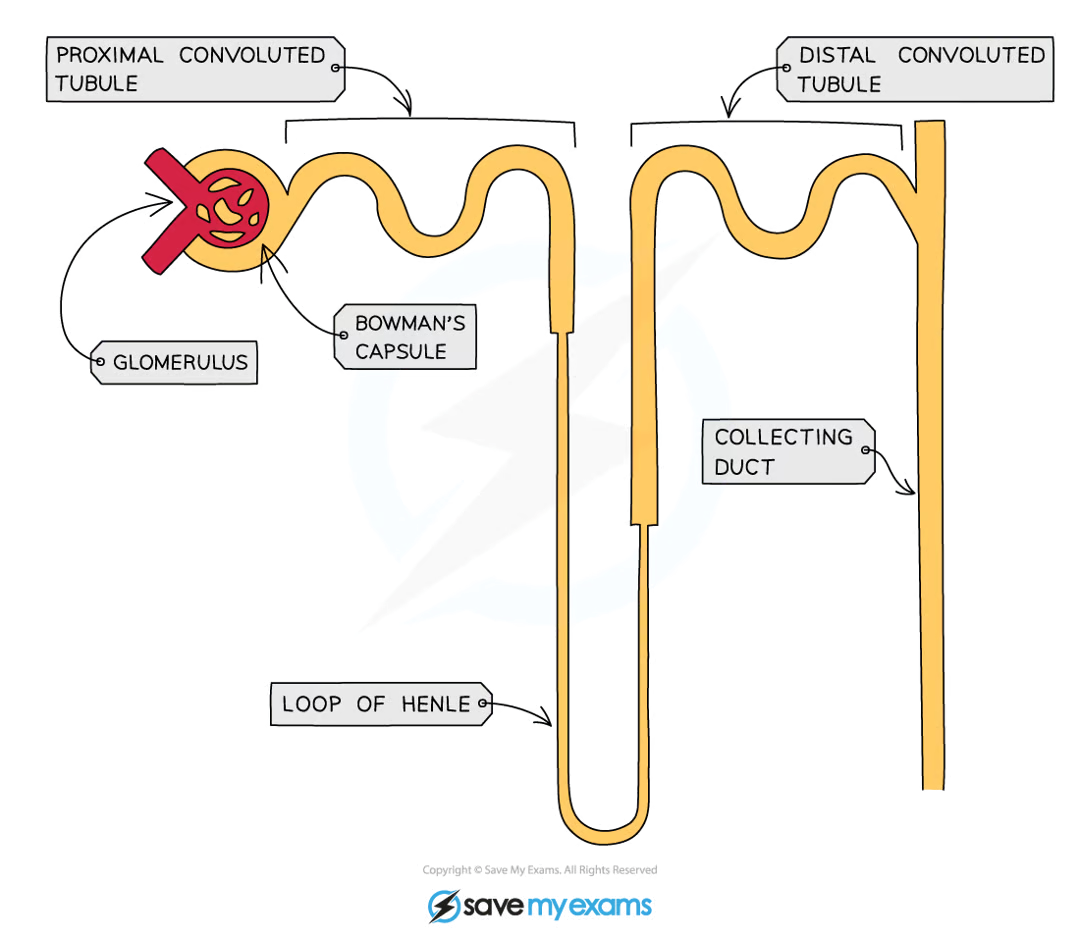
function of a nephron
kidneys filter the blood before reabsorbing useful substances prior to waste excretion
process:
ultrafiltration
selective reabsorption of glucose
selective reabsorption of water and salts
how does ultrafiltration work
arterioles branch off renal artery and lead to each nephron, where they form a bundle of capillaries (glomerulus) sitting inside the Bowman’s capsule
capsule gets narrower as they get further into the glomerulus which increases blood pressure
eventually causes smaller molecules in blood to be forced out of capillaries into the bowman’s capsule, where they form glomerular filtrate; substances in filtrate include:
glucose
water
urea
salts
some components are useful and will be reabsorbed back into the blood further down the nephron
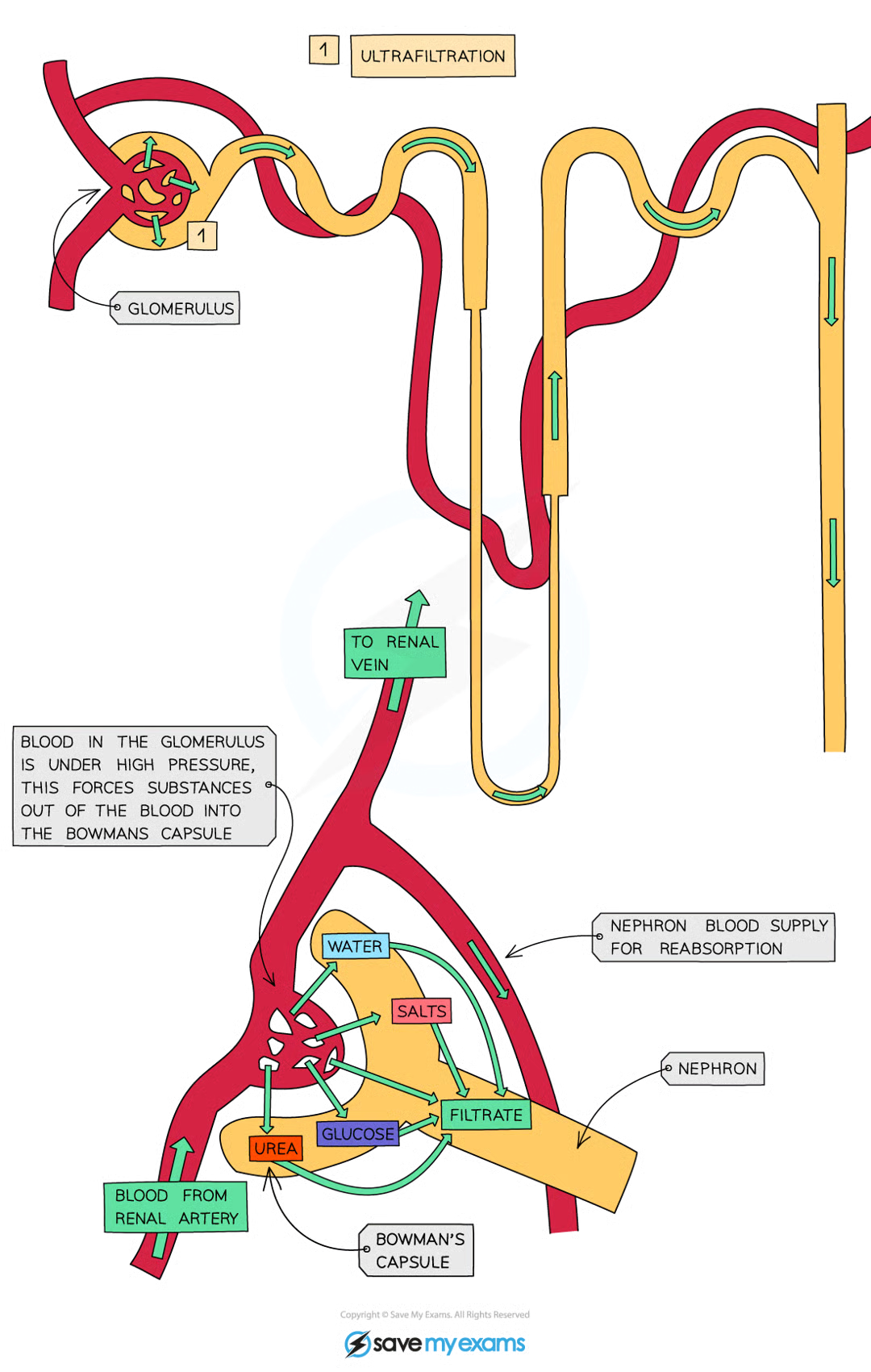
how does selective reabsorption work
after glomerular filtrate enters BC, glucose is first substance to be reabsorbed at the proximal (first) convoluted tubule
takes place by active transport
nephron adaptation: many mitochondria to provide energy for active transport of glucose
reabsorption of glucose cannot take place anywhere else in nephron as gates that facilitate active transport of glucose are only found in proximal convoluted tubule
people with normal blood glucose levels have enough gates to remove all glucose from filtrate back into blood
people with diabetes cannot control blood glucose levels (often too high) so not all glucose filtered out can be reabsorbed into blood in proximal convoluted tubule
singe there is nowhere else for glucose to be reabsorbed, continues in filtrate into urine
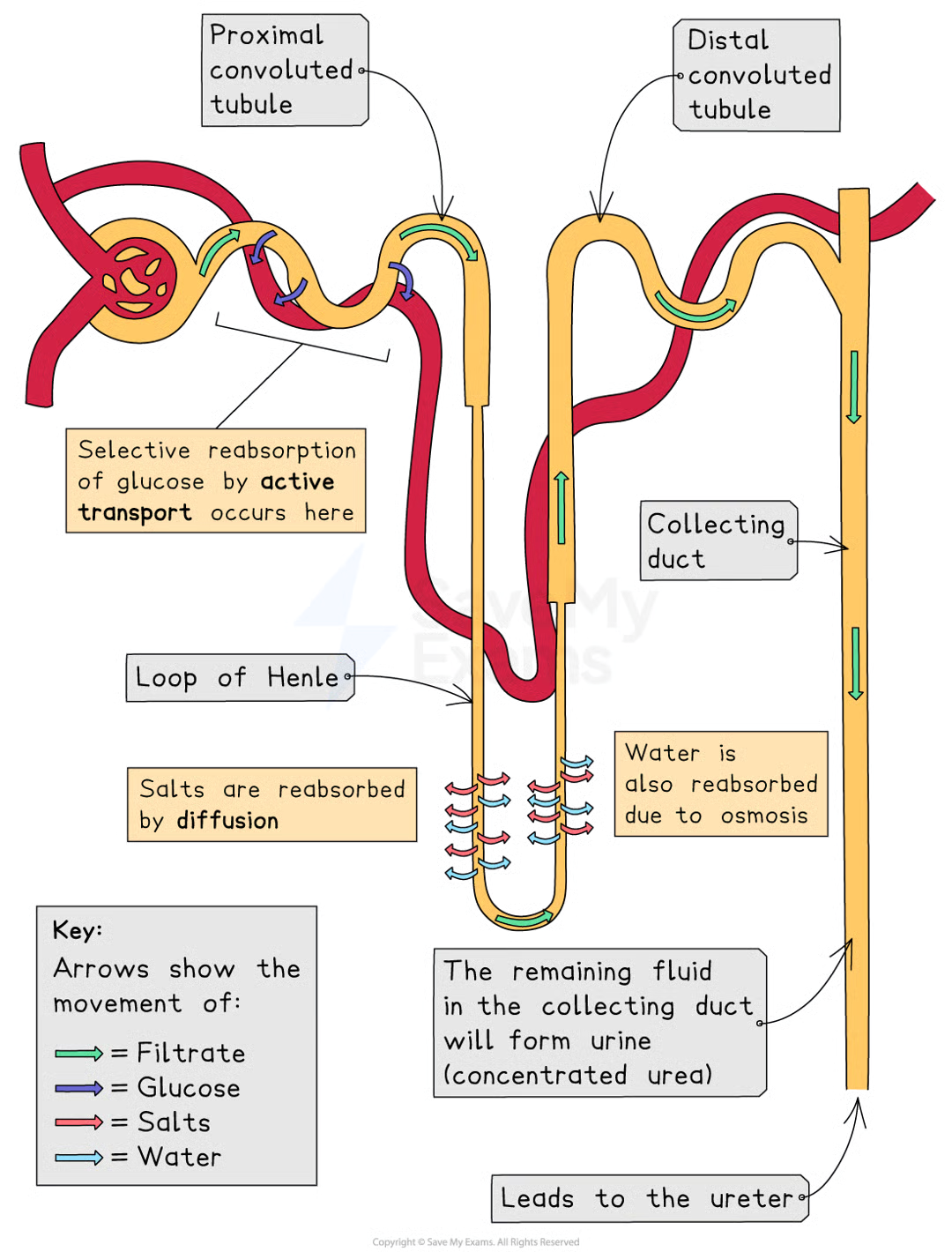
how does reabsorption of water work
as filtrate drips through loop of henle, necessary salts are reabsorbed back into blood by diffusion and active transport
as salts are reabsorbed back into blood, water follows by osmosis
water is also reabsorbed from collecting duct in different amounts depending on how much water the body needs at the time
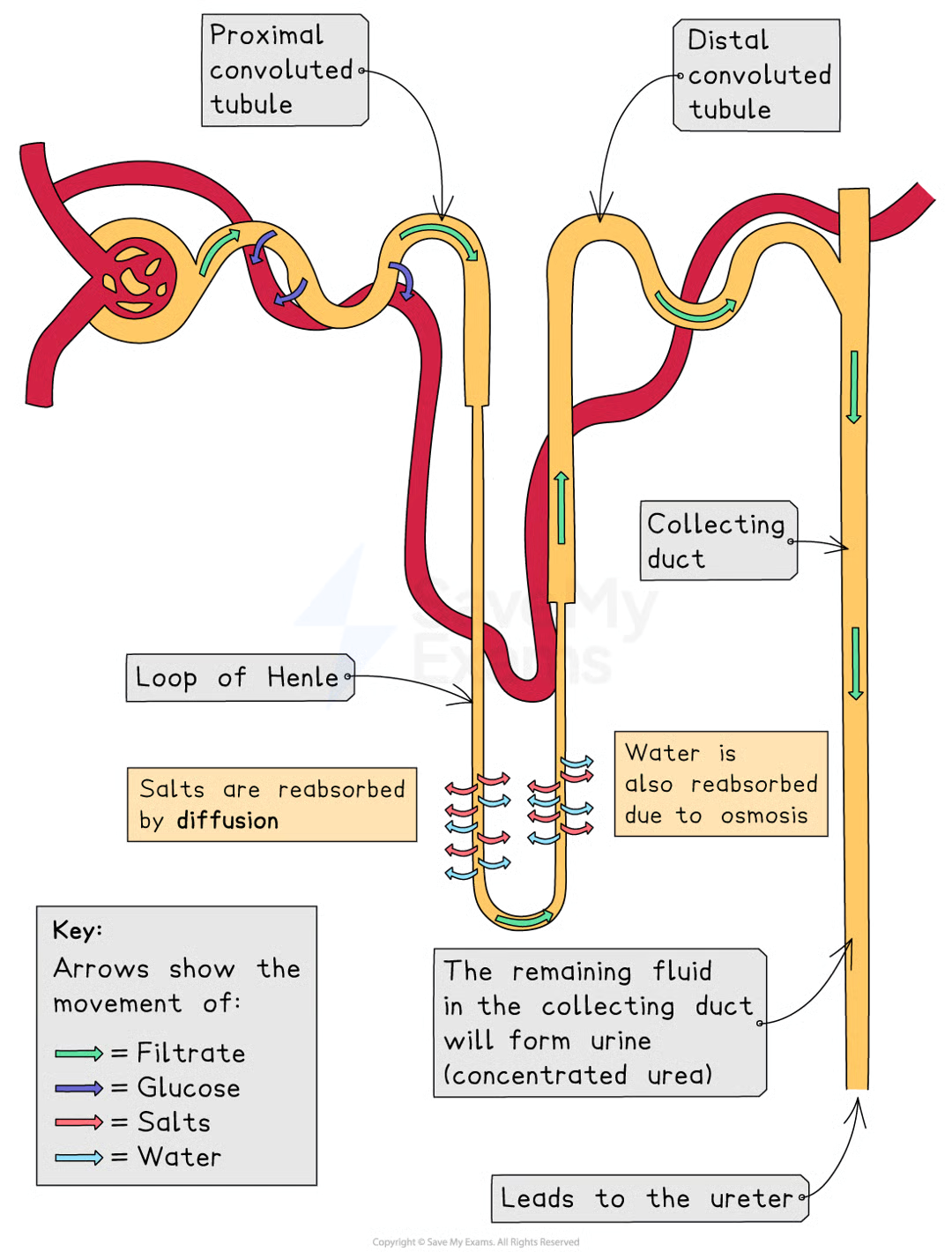
role of ADH
water reabsorption happens along nephron tubules in kidneys - important for osmoregulation
control of water reabsorption by tubules is example of negative feedback e.g. if water content of blood is too high, less water reabsorbed, if too low, more water reabsorbed - controlled by ADH
changes in water level of blood detected by hypothalamus, sends signal to pituitary gland
pituitary gland changes how much ADH released
ADH affects permeability of tubules to water
if water content of blood too high:
pituitary gland releases less ADH, so less water is reabsorbed in collecting ducts as they become less permeable to water
kidneys produce large volume of dilute urine
if water content in blood too low:
pituitary gland releases more ADH which leads to more water being reabsorbed in ducts as ducts are more permeable to water
kidneys produce small volume of concentrated urine
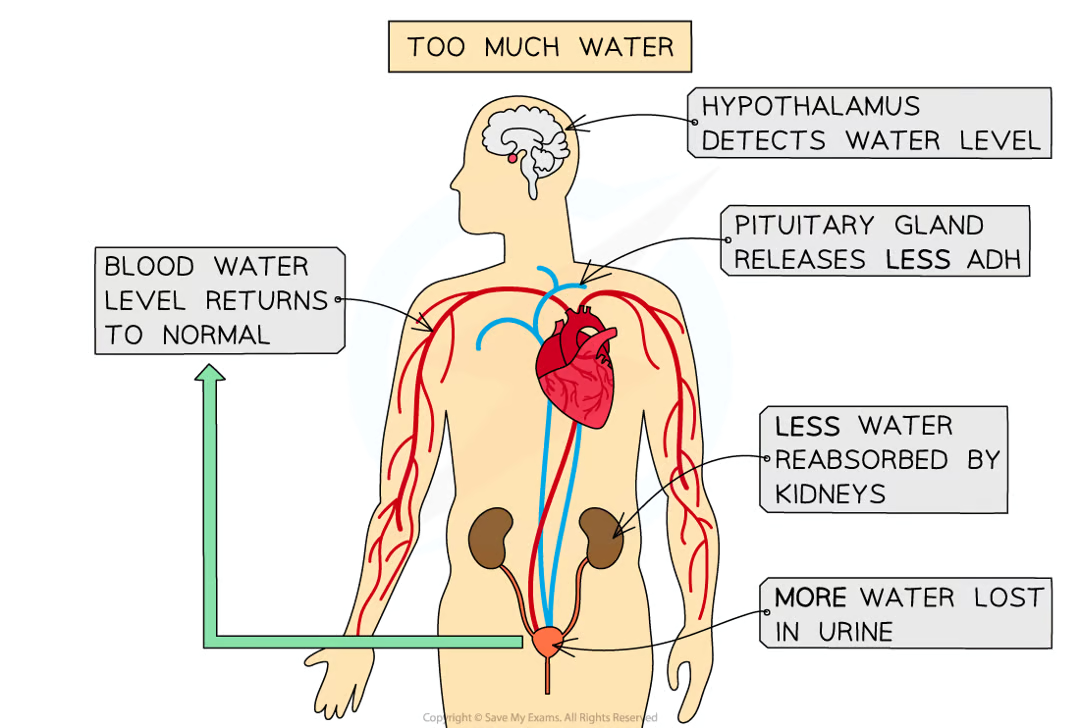
composition of urine
urea
excess mineral ions
excess water
colour and quantity changes quickly
large quantities are usually pale yellow as urea is less concentrated due to high water levels
small quantities are usually darker as they contain little water so urea is more concentrated
can change due to:
water intake - the more fluids drunk, the more water will be removed from the body and so a large quantity of pale yellow, dilute urine will be produced
temperature - the higher the temperature the more water is lost in sweat and so less will appear in the urine, meaning a smaller quantity of dark yellow, concentrated urine will be produced
exercise - the greater the level of exercise, the more water is lost in sweat and so less will appear in the urine, meaning a smaller quantity of dark yellow, concentrated urine will be produced